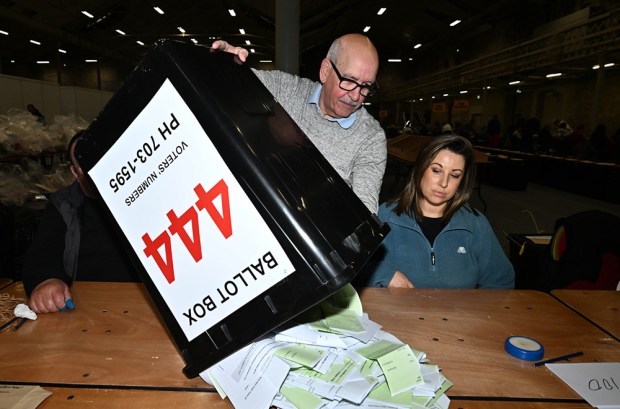Like a latter day Aussie Marie Antoinette, Geoff Cousins, president of the Australian Conservation Foundation, wants the poor of India to mind their emissions.
Let them eat renewables! He’s calling for them to abstain from coal and move straight to solar technology so cutting-edge it hasn’t yet made it out of the labs at CSIRO.
If Cousins and his rich Green chums want to go coal turkey, fine. They can afford to practice what they preach and should go off grid. The average two-person home in ritzy harbourside suburbs where the likes of Cousins live uses about 23 kilowatts a day. To generate that you’d need to install 24 panels of 250W, a snip at $70,000. Geoff or his well-thonged greeny mates could easily pay twice that to power up all the mod cons at their trendy beach shacks, too.
But it would not be so easy for the 37 per cent of Indians living on less than $1.25 a day. Around 240 million people – one in five – have limited or no access to electricity. And even if aid donors were to foot the entire bill, the cost of renewables is so high that the money to provide solar or wind-powered energy to one person will provide coal-fired power for 13 people. So you could either help all 240 million people or just 18 million people.
The other 222 million would miss out not just on electricity but everything that you can do with it – clean water, sanitation, lighting, heating, mechanical power, transport, telecommunications and clean air in the home because you don’t have to burn firewood, dung, straw, coal or charcoal to cook.
Indoor air pollution causes pneumonia, chronic obstructive pulmonary disease and lung cancer and is responsible for between 4 to 6 per cent of India’s national disease burden and 1.6 million deaths globally. Women suffer more because they spend up to seven hours a day near the stove. And 56 per cent of children who die from indoor pollution are under five years old. Another 98,000 people in India, 2.2 million globally, most children, die from diarrhoea each year.
Modern agriculture requires fossil fuel-fired blast furnaces to make mechanised equipment. Fertiliser is a byproduct. Without this, India can’t grow enough crops. Result? One third of the world’s malnourished children live in India. Poverty drives age-old traditions. One in three girls become child brides, the highest rate in the world.
Forcing the developing world onto expensive renewables cruelly punishes the poor.
But just imagine what Cousins’ coal-free utopia would look like here. The end of coal would also mean the end of steel because every tonne requires 800kgs of metallurgical coal.
Kiss goodbye to your wind turbine. It has 220 tonnes of thermal and metallurgical coal in it including the tower, which is 90 per cent steel, the generator, which is 65 per cent steel and the base, which is steel reinforced concrete.
And manufacturing wind turbines and solar panels, batteries and other green technology, such as LEDs and heat pumps, requires fossil fuel-powered furnaces to reach the intense temperatures required.
But wind turbines are just the beginning. Steel is the most widely used metal on earth. It is in buildings, cladding, suspension cables, tunnels, harbours, trucks, trains, rails, ships, aircraft, engines, transmission towers, food and beverage containers, fridges, washing machines, ovens, microwaves, sinks, cutlery and surgical equipment.
And coal is used in the chemical and pharmaceutical industries, to refine alumina, manufacture paper, make mountain bikes, tennis rackets, resins, cosmetics, shampoo, toothpaste and the carbon filters in kidney dialysis machines. Coal by-products are used to make soap, aspirin, dyes, nylon and rayon.
Yes, India does want to increase its use of state-owned coal but chronic domestic supply problems mean imports are rapidly increasing. Around 113 gigawatts of new coal-fired power capacity is under construction – more than twice all the energy capacity in Australia. So Indian thermal coal imports are expected to increase to 191 MT this year and 204 MT next year, with India overtaking Japan, the EU and China this decade to become the largest importer of coal in the world.
And that’s no bad thing. On average, Australian black coal is the cleanest in the world. It has higher energy content and lower ash content than Indian coal.
From 2017 there are plans that all new coal-fired power plants in India will use supercritical technology, which is optimised by using Australia’s black coal, reducing emissions up to 40 per cent per watt. Which is why the Carmichael mine in the Galilee Basin, being developed by Adani, an Indian company, and opposed by the ACF, will help India leapfrog over others to become one of the countries whose coal-fired power generators have the lowest emissions intensity on the planet.
The UN estimates the world population will grow by 68 million people a year through to 2050. The largest urban growth will take place in India with 11 million people urbanised each year. Without the power provided by fossil fuels, these people will be condemned to lives of Dickensian poverty.
It is hypocritical, callously cynical, and yes, immoral, to tell them to use the most expensive and inefficient energy available. Every dollar spent on current generation wind and solar power that relies on fossil fuels base load power as a backup is a dollar wasted, here or in India, because you can’t incrementally cut base load power. Our coal-fired plants have to run continuously. You can’t turn them off because it’s breezy in Bangalore or sunny in Sydney.
So that dollar spent on intermittent renewables won’t cut a single emission. Yet it could have been spent preventing malaria or treating the 2.4 million Indians (40 per cent women, 3.5 per cent children) with HIV/AIDS.
Or spent on research to develop cheap renewable, low-emissions energy. Until then, renewables are a rich man’s indulgence at the expense of the poor.
Got something to add? Join the discussion and comment below.
Get 10 issues for just $10
Subscribe to The Spectator Australia today for the next 10 magazine issues, plus full online access, for just $10.
Rebecca Weisser is a freelance journalist and regular contributor to The Spectator Australia
You might disagree with half of it, but you’ll enjoy reading all of it. Try your first month for free, then just $2 a week for the remainder of your first year.













Comments
Don't miss out
Join the conversation with other Spectator Australia readers. Subscribe to leave a comment.
SUBSCRIBEAlready a subscriber? Log in